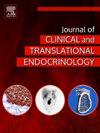Hormone responses to buserelin in polycystic ovary syndrome and in eumenorrheic women with hyperandrogenism/hyperandrogenemia, and the relationship of these responses with insulin resistance
IF 3.3
Q1 ENDOCRINOLOGY & METABOLISM
Journal of Clinical and Translational Endocrinology
Pub Date : 2025-10-02
DOI:10.1016/j.jcte.2025.100420
引用次数: 0
Abstract
We compared 37 women with polycystic ovary syndrome (PCOS) with 24 women with eumenorrhea plus hyperandrogenism and/or hyperandrogenemia without ultrasound evidence of PCO morphology (EuHyperA) to assess their hormone responses to a GnRH-agonist (buserelin). Following our recent paper on PCOS and EuHyperA, we selected patients who performed the 2 h-oral glucose tolerance test (OGTT), and stratified them according to presence/absence of insulin resistance (IR), viz. HOMA-index ≥ 2.5.
IR impacted on the PCOS group since IR-yes-PCOS women had significantly higher body weight, BMI, total testosterone (TT), free androgen index (FAI), and 17-hydroxyprogesterone (17-OHP), borderline higher delta-4 androstenedione (Δ4-ASD) and ovarian volume, and significantly lower sex hormone-binding globulin (SHBG) vs IR-no-PCOS. IR-no-EuHyperA had significantly higher follicle-stimulating hormone (FSH), borderline higher dehydroepiandrosterone sulfate (DHEAS) and borderline lower 17-OHP vs IR-no-PCOS. IR-yes-EuHyperA had significantly higher DHEAS, borderline lower TT and FAI vs IR-yes-PCOS.
The insulin curve was significantly higher in the IR-yes vs IR-no-PCOS, and IR-yes vs IR-no-EuHyperA. Compared to PCOS, EuHyperA had insignificantly lower glucose and insulin responses regardless of IR status.
After steroidogenic ovarian stimulation (24 h-buserelin test), IR presence vs IR absence impacted on 4 curves in PCOS (significantly higher TT, borderline higher 17-OHP, significantly lower Δ4-ASD and DHEAS), and only one curve in EuHyperA (significantly higher TT). IR-no-EuHyperA had two curves significantly lower than IR-no-PCOS (Δ4-ASD and TT). Instead, IR-yes-EuHyperA had significantly lower Δ4-ASD, TT and 17-OHP curves, and significantly higher DHEAS curve vs IR-yes-PCOS.
In conclusion, of 35 parameters (baseline, OGTT-related, buserelin-related), 28 (80%) were statistically similar in EuHyperA vs PCOS regardless of IR status. However, IR presence impacted on more parameters in PCOS than EuHyperA. Given the known ovary sparing by IR in PCOS, it appears that IR exacerbates androgen production of PCOS women more markedly than EuHyperA women.
多囊卵巢综合征和伴有高雄激素症/高雄激素血症的痛经妇女对布瑟林的激素反应及其与胰岛素抵抗的关系
我们比较了37名患有多囊卵巢综合征(PCOS)的女性和24名没有超声显示PCOS形态(EuHyperA)的痛经合并雄激素过多和/或雄激素过多的女性,以评估她们对gnrh激动剂(buserelin)的激素反应。根据我们最近关于PCOS和EuHyperA的论文,我们选择了接受2小时口服葡萄糖耐量试验(OGTT)的患者,并根据是否存在胰岛素抵抗(IR)(即HOMA-index≥2.5)对他们进行分层。IR对PCOS组有影响,因为IR-有PCOS的女性体重、BMI、总睾酮(TT)、游离雄激素指数(FAI)和17-羟孕酮(17-OHP)明显高于无PCOS的女性,δ -4雄烯二酮(Δ4-ASD)和卵巢体积呈边缘性升高,性激素结合球蛋白(SHBG)明显低于IR-无PCOS的女性。与IR-no-PCOS相比,IR-no-EuHyperA的促卵泡激素(FSH)显著升高,脱氢表雄酮硫酸酯(DHEAS)水平升高,17-OHP水平降低。与IR-yes-PCOS相比,IR-yes-EuHyperA的DHEAS明显升高,TT和FAI边缘性降低。胰岛素曲线在ir -存在与ir -不存在pcos, ir -存在与ir -不存在euhypera患者中显著升高。与PCOS相比,无论IR状态如何,EuHyperA的血糖和胰岛素反应均不显著降低。激素性卵巢刺激(24 h-buserelin试验)后,IR的存在与不存在影响PCOS的4条曲线(TT显著升高,17-OHP临界升高,Δ4-ASD和DHEAS显著降低),而EuHyperA只有一条曲线(TT显著升高)。IR-no-EuHyperA有两条曲线明显低于IR-no-PCOS (Δ4-ASD和TT)。与IR-yes-PCOS相比,IR-yes-EuHyperA的Δ4-ASD、TT和17-OHP曲线显著降低,DHEAS曲线显著升高。总之,在35个参数(基线,ogtt相关,buserelin相关)中,28个(80%)在EuHyperA和PCOS中具有统计学上的相似性,无论IR状态如何。然而,与EuHyperA相比,IR的存在对PCOS的参数影响更多。鉴于已知的PCOS中IR对卵巢的保护作用,似乎IR比EuHyperA女性更明显地加剧了PCOS女性的雄激素分泌。
本文章由计算机程序翻译,如有差异,请以英文原文为准。
求助全文
约1分钟内获得全文
求助全文
来源期刊

Journal of Clinical and Translational Endocrinology
ENDOCRINOLOGY & METABOLISM-
CiteScore
6.10
自引率
0.00%
发文量
24
审稿时长
16 weeks
 求助内容:
求助内容: 应助结果提醒方式:
应助结果提醒方式:


